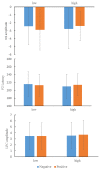Self-esteem modulates the time course of self-positivity bias in explicit self-evaluation
- PMID: 24339908
- PMCID: PMC3855207
- DOI: 10.1371/journal.pone.0081169
Self-esteem modulates the time course of self-positivity bias in explicit self-evaluation
Abstract
Researchers have suggested that certain individuals may show a self-positivity bias, rating themselves as possessing more positive personality traits than others. Previous evidence has shown that people evaluate self-related information in such a way as to maintain or enhance self-esteem. However, whether self-esteem would modulate the time course of self-positivity bias in explicit self-evaluation has never been explored. In the present study, 21 participants completed the Rosenberg self-esteem scale and then completed a task where they were instructed to indicate to what extent positive/negative traits described themselves. Behavioral data showed that participants endorsed positive traits as higher in self-relevance compared to the negative traits. Further, participants' self-esteem levels were positively correlated with their self-positivity bias. Electrophysiological data revealed smaller N1 amplitude and larger late positive component (LPC) amplitude to stimuli consistent with the self-positivity bias (positive-high self-relevant stimuli) when compared to stimuli that were inconsistent with the self-positivity bias (positive-low self-relevant stimuli). Moreover, only in individuals with low self-esteem, the latency of P2 was more pronounced in processing stimuli that were consistent with the self-positivity bias (negative-low self-relevant stimuli) than to stimuli that were inconsistent with the self-positivity bias (positive-low self-relevant stimuli). Overall, the present study provides additional support for the view that low self-esteem as a personality variable would affect the early attentional processing.
Conflict of interest statement
Figures


Similar articles
-
Modulation of self-esteem in self- and other-evaluations primed by subliminal and supraliminal faces.PLoS One. 2012;7(10):e47103. doi: 10.1371/journal.pone.0047103. Epub 2012 Oct 16. PLoS One. 2012. PMID: 23091607 Free PMC article.
-
Self-esteem modulates dorsal medial prefrontal cortical response to self-positivity bias in implicit self-relevant processing.Soc Cogn Affect Neurosci. 2014 Nov;9(11):1814-8. doi: 10.1093/scan/nst181. Epub 2014 Jan 5. Soc Cogn Affect Neurosci. 2014. PMID: 24396003 Free PMC article.
-
Lower self-positivity and its association with self-esteem in women with borderline personality disorder.Behav Res Ther. 2018 Oct;109:84-93. doi: 10.1016/j.brat.2018.07.008. Epub 2018 Aug 2. Behav Res Ther. 2018. PMID: 30165335
-
The paranoia as defence model of persecutory delusions: a systematic review and meta-analysis.Lancet Psychiatry. 2018 Nov;5(11):913-929. doi: 10.1016/S2215-0366(18)30339-0. Epub 2018 Oct 9. Lancet Psychiatry. 2018. PMID: 30314852
-
Understanding Negative Self-Evaluations in Borderline Personality Disorder-a Review of Self-Related Cognitions, Emotions, and Motives.Curr Psychiatry Rep. 2017 Mar;19(3):17. doi: 10.1007/s11920-017-0771-0. Curr Psychiatry Rep. 2017. PMID: 28290062 Review.
Cited by
-
Self-Reference Emerges Earlier than Emotion during an Implicit Self-Referential Emotion Processing Task: Event-Related Potential Evidence.Front Hum Neurosci. 2017 Sep 8;11:451. doi: 10.3389/fnhum.2017.00451. eCollection 2017. Front Hum Neurosci. 2017. PMID: 28943845 Free PMC article.
-
Adolescent Gender Differences in Cognitive Control Performance and Functional Connectivity Between Default Mode and Fronto-Parietal Networks Within a Self-Referential Context.Front Behav Neurosci. 2018 Apr 23;12:73. doi: 10.3389/fnbeh.2018.00073. eCollection 2018. Front Behav Neurosci. 2018. PMID: 29740292 Free PMC article.
-
Lonely Individuals Do Not Show Interpersonal Self-Positivity Bias: Evidence From N400.Front Psychol. 2018 Apr 6;9:473. doi: 10.3389/fpsyg.2018.00473. eCollection 2018. Front Psychol. 2018. PMID: 29681875 Free PMC article.
-
Meaning in military service among reservists: Measuring the effect of prosocial motivation in a moderated-mediation model.Front Psychol. 2023 Feb 9;14:1082685. doi: 10.3389/fpsyg.2023.1082685. eCollection 2023. Front Psychol. 2023. PMID: 36844339 Free PMC article.
-
Are covered faces eye-catching for us? The impact of masks on attentional processing of self and other faces during the COVID-19 pandemic.Cortex. 2022 Apr;149:173-187. doi: 10.1016/j.cortex.2022.01.015. Epub 2022 Feb 10. Cortex. 2022. PMID: 35257944 Free PMC article.
References
-
- Lin YC, Lin CH, Raghubir P (2003) Avoiding Anxiety, Being in Denial, or Simply Stroking Self-Esteem: Why Self-Positivity? Journal of Consumer Psychology 13: 464–477.
-
- Leary MR (2007) Modulational and Emotional Aspcts of the Self. Annu Rev Psycho 58: 317–344. - PubMed
-
- Alicke MD, Klotz ML, Breitenbecher DL, Yurak TJ, Vredenburg DS (1995) Personal contact, individuation, and the better-than-average effect. Journal of Personality and Social Psychology 68: 804–825.
-
- Brown JD, Kobayashi C (2002) Self-enhancement in Japan and America. Asian Journal of Social Psychology 5: 145–167.
-
- Sedikides C, Gaertner L, Toguchi Y (2003) Pancultural self-enhancement. J Pers Soc Psychol 84: 60–79. - PubMed
Publication types
MeSH terms
LinkOut - more resources
Full Text Sources
Other Literature Sources

